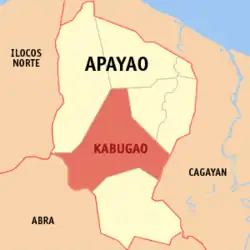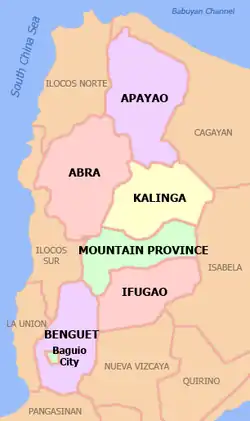Kabugao
Kabugao, officially the Municipality of Kabugao (Ilocano: Ili ti Kabugao; Tagalog: Bayan ng Kabugao), is a 1st class municipality and de jure capital of the province of Apayao, Philippines. According to the 2020 census, it has a population of 16,215 people.[3]
Kabugao | |
|---|---|
| Municipality of Kabugao | |
 Landscape in Barangay Dibagat | |
 Flag | |
 Map of Apayao with Kabugao highlighted | |
OpenStreetMap | |
.svg.png.webp) Kabugao Location within the Philippines | |
| Coordinates: 18°01′26″N 121°11′00″E | |
| Country | Philippines |
| Region | Cordillera Administrative Region |
| Province | Apayao |
| District | Lone district |
| Founded | 1950 |
| Barangays | 21 (see Barangays) |
| Government | |
| • Type | Sangguniang Bayan |
| • Mayor | Bensmar B. Ligwang (PRP) |
| • Vice Mayor | Fabulous B. Tucjang (NPC) |
| • Representative | Eleanor Bulut-Begtang |
| • Municipal Council | Members |
| • Electorate | 11,773 voters (2022) |
| Area | |
| • Total | 935.12 km2 (361.05 sq mi) |
| Elevation | 262 m (860 ft) |
| Highest elevation | 689 m (2,260 ft) |
| Lowest elevation | 78 m (256 ft) |
| Population (2020 census)[3] | |
| • Total | 16,215 |
| • Density | 17/km2 (45/sq mi) |
| • Households | 3,506 |
| Economy | |
| • Income class | 1st municipal income class |
| • Poverty incidence | 35.34 |
| • Revenue | ₱ 241.7 million (2020) |
| • Assets | ₱ 416.7 million (2020) |
| • Expenditure | ₱ 183.6 million (2020) |
| • Liabilities | ₱ 66.38 million (2020) |
| Service provider | |
| • Electricity | Kalinga - Apayao Electric Cooperative (KAELCO) |
| Time zone | UTC+8 (PST) |
| ZIP code | 3809 |
| PSGC | |
| IDD : area code | +63 (0)74 |
| Native languages | Isnag Itawis Ilocano Tagalog |
Kabugao is 606 kilometres (377 mi) from Manila.
History
On July 12, 1915, Governor General Francis Burton Harrison issued Executive Order No. 45, transferring the capital of then sub-province of Apayao from Tauit to Kabugao, to be effective on August 1.[5]
Kabugao was occupied for a year by the Japanese during the Second World War.[6] It was captured in December 1942, after the USAFIP NL retreated from the town.
Cityhood
In the 19th Congress of the Philippines, house bills were filed by various representatives which seeks Kabugao including other capital towns of provinces with no current component cities, independent component cities, or highly urbanized cities to automatically convert into cities.[7][8][9]
Geography
According to the Philippine Statistics Authority, the municipality has a land area of 935.12 square kilometres (361.05 sq mi) [10] constituting 21.19% of the 4,413.35-square-kilometre- (1,704.00 sq mi) total area of Apayao.
Barangays
Kabugao is politically subdivided into 21 barangays.[11] Each barangay consists of puroks and some have sitios.
| PSGC | Barangay | Population | ±% p.a. | |||
|---|---|---|---|---|---|---|
| 2020[3] | 2010[12] | |||||
| 148104001 | Badduat | 5.8% | 943 | 1,000 | −0.59% | |
| 148104002 | Baliwanan | 3.0% | 480 | 478 | 0.04% | |
| 148104004 | Bulu | 1.8% | 297 | 298 | −0.03% | |
| 148104007 | Cabetayan | 3.8% | 613 | 556 | 0.98% | |
| 148104005 | Dagara | 3.3% | 541 | 484 | 1.12% | |
| 148104006 | Dibagat | 4.3% | 704 | 797 | −1.23% | |
| 148104008 | Karagawan | 4.0% | 655 | 676 | −0.32% | |
| 148104009 | Kumao | 3.5% | 570 | 557 | 0.23% | |
| 148104010 | Laco | 2.5% | 411 | 410 | 0.02% | |
| 148104011 | Lenneng (Liyyeng) | 15.7% | 2,541 | 2,396 | 0.59% | |
| 148104012 | Lucab | 3.7% | 604 | 660 | −0.88% | |
| 148104013 | Luttuacan | 6.4% | 1,042 | 786 | 2.86% | |
| 148104014 | Madatag | 4.9% | 798 | 766 | 0.41% | |
| 148104015 | Madduang | 2.9% | 467 | 423 | 0.99% | |
| 148104016 | Magabta | 1.3% | 203 | 215 | −0.57% | |
| 148104017 | Maragat | 2.8% | 453 | 503 | −1.04% | |
| 148104018 | Musimut | 3.7% | 607 | 822 | −2.99% | |
| 148104019 | Nagbabalayan | 3.0% | 482 | 511 | −0.58% | |
| 148104020 | Poblacion | 16.2% | 2,629 | 3,217 | −2.00% | |
| 148104021 | Tuyangan | 1.8% | 285 | 334 | −1.57% | |
| 148104022 | Waga | 1.3% | 212 | 281 | −2.78% | |
| Total | 16,215 | 16,170 | 0.03% | |||
Climate
| Climate data for Kabugao, Apayao | |||||||||||||
|---|---|---|---|---|---|---|---|---|---|---|---|---|---|
| Month | Jan | Feb | Mar | Apr | May | Jun | Jul | Aug | Sep | Oct | Nov | Dec | Year |
| Average high °C (°F) | 25 (77) |
26 (79) |
29 (84) |
31 (88) |
31 (88) |
31 (88) |
30 (86) |
30 (86) |
29 (84) |
28 (82) |
27 (81) |
25 (77) |
29 (83) |
| Average low °C (°F) | 20 (68) |
20 (68) |
21 (70) |
23 (73) |
24 (75) |
24 (75) |
24 (75) |
24 (75) |
24 (75) |
23 (73) |
22 (72) |
21 (70) |
23 (72) |
| Average precipitation mm (inches) | 133 (5.2) |
87 (3.4) |
68 (2.7) |
44 (1.7) |
127 (5.0) |
134 (5.3) |
160 (6.3) |
162 (6.4) |
134 (5.3) |
192 (7.6) |
194 (7.6) |
260 (10.2) |
1,695 (66.7) |
| Average rainy days | 18.1 | 13.3 | 13.3 | 11.8 | 19.7 | 20.9 | 22.8 | 22.8 | 20.3 | 16.6 | 18.4 | 21.7 | 219.7 |
| Source: Meteoblue[13] | |||||||||||||
Demographics
| Year | Pop. | ±% p.a. |
|---|---|---|
| 1918 | 3,448 | — |
| 1939 | 4,646 | +1.43% |
| 1948 | 4,545 | −0.24% |
| 1960 | 5,961 | +2.29% |
| 1970 | 7,358 | +2.13% |
| 1975 | 8,720 | +3.46% |
| 1980 | 9,600 | +1.94% |
| 1990 | 11,198 | +1.55% |
| 1995 | 12,710 | +2.40% |
| 2000 | 13,985 | +2.07% |
| 2007 | 14,529 | +0.53% |
| 2010 | 16,170 | +3.97% |
| 2015 | 15,537 | −0.76% |
| 2020 | 16,215 | +0.84% |
| Source: Philippine Statistics Authority[14][12][15][16] | ||
In the 2020 census, Kabugao had a population of 16,215.[3] The population density was 17 inhabitants per square kilometre (44/sq mi).
Economy
Government
Local government
Kabugao, belonging to the lone congressional district of the province of Apayao, is governed by a mayor designated as its local chief executive and by a municipal council as its legislative body in accordance with the Local Government Code. The mayor, vice mayor, and the councilors are elected directly by the people through an election which is being held every three years.
Elected officials
| Position | Name |
|---|---|
| Congressman | Elias C. Bulut Jr. |
| Mayor | Bensmar B. Ligwang |
| Vice-Mayor | Joseph C. Amid |
| Councilors | Jed E. Bosing |
| Marlene B. Tapiru | |
| Paterno C. Amid | |
| Alberto B. Tucjang | |
| Gregorio B. Ligwang | |
| Macpaul L. Talimbong | |
| Max T. Basang | |
| Sedolito Bernard A. Agunos | |
Education
In 1948, Rev. Louis Saunders of an evangelical Protestant sect, The Disciples of Christ, opened the Apayao Christian Academy, Kabugao's first secondary school. In 1950, amidst rivalry among churches, the Catholics started its own secondary school, Our Blessed Lady of Lourdes.[6]
Dibagat

Dibagat is inhabited by the Isnag and the Ilocano. There is a small grass airstrip built by SIL in 1985. Dibagat is accessible only by canoe or by specialized aircraft.
References
- Municipality of Kabugao | (DILG)
- "2015 Census of Population, Report No. 3 – Population, Land Area, and Population Density" (PDF). Philippine Statistics Authority. Quezon City, Philippines. August 2016. ISSN 0117-1453. Archived (PDF) from the original on May 25, 2021. Retrieved July 16, 2021.
- Census of Population (2020). "Cordillera Administrative Region (CAR)". Total Population by Province, City, Municipality and Barangay. Philippine Statistics Authority. Retrieved July 8, 2021.
- "PSA Releases the 2018 Municipal and City Level Poverty Estimates". Philippine Statistics Authority. December 15, 2021. Retrieved January 22, 2022.
- Executive Orders, 1915. Manila: Bureau of Printing. 1916. pp. 91–92. Retrieved August 2, 2022.
- "The Manolay cult: The genesis and dissolution of millenarian sentiments among the Isneg of Northern Luzon" (PDF). Asian Studies. University of the Philippines Diliman. Retrieved July 31, 2022.
- Yap, Eric (June 30, 2022). "AN ACT AUTOMATICALLY CONVERTING THE CAPITAL TOWN OF PROVINCES WITH NO COMPONENT CITIES, INDEPENDENT COMPONENT CITIES OR HIGHLY URBANIZED CITIES WITHIN ITS TERRITORIAL JURISDICTION, INTO A COMPONENT CITY" (PDF). House of Representatives of the Philippines. Retrieved April 1, 2023.
- Palma, Wilter (August 9, 2022). "AN ACT AUTOMATICALLY CONVERTING THE CAPITAL TOWN OF PROVINCES WITH NO COMPONENT CITIES, INDEPENDENT COMPONENT CITIES, OR HIGHLY URBANIZED CITIES WITHIN ITS TERRITORIAL JURISDICTION, INTO A COMPONENT CITY" (PDF). House of Representatives of the Philippines. Retrieved April 1, 2023.
- Daza, Paul (August 11, 2022). "AN ACT CONVERING INTO COMPONENT CITIES THE CAPITAL TOWNS OF PROVINCES WITHOUT A CITY, AMENDING FOR THE PURPOSE SECTION 450 OF REPUBLIC ACT NO. 7610, AS AMENDED BY REPUBLIC ACT NO. 9009, OTHERWISE KNOWN AS THE LOCAL GOVERNMENT CODE OF 1991, AND FOR OTHER PURPOSES" (PDF). House of Representatives of the Philippines. Retrieved April 1, 2023.
- "Province: Apayao". PSGC Interactive. Quezon City, Philippines: Philippine Statistics Authority. Retrieved November 12, 2016.
- "Municipal: Kabugao". PSGC Interactive. Quezon City, Philippines: Philippine Statistics Authority. Retrieved January 8, 2016.
- Census of Population and Housing (2010). "Cordillera Administrative Region (CAR)" (PDF). Total Population by Province, City, Municipality and Barangay. National Statistics Office. Retrieved June 29, 2016.
- "Kabugao: Average Temperatures and Rainfall". Meteoblue. Retrieved March 8, 2020.
- Census of Population (2015). "Cordillera Administrative Region (CAR)". Total Population by Province, City, Municipality and Barangay. Philippine Statistics Authority. Retrieved June 20, 2016.
- Censuses of Population (1903–2007). "Cordillera Administrative Region (CAR)". Table 1. Population Enumerated in Various Censuses by Province/Highly Urbanized City: 1903 to 2007. National Statistics Office.
- "Province of Apayao". Municipality Population Data. Local Water Utilities Administration Research Division. Retrieved December 17, 2016.
- "Poverty incidence (PI):". Philippine Statistics Authority. Retrieved December 28, 2020.
- "Estimation of Local Poverty in the Philippines" (PDF). Philippine Statistics Authority. November 29, 2005.
- "2003 City and Municipal Level Poverty Estimates" (PDF). Philippine Statistics Authority. March 23, 2009.
- "City and Municipal Level Poverty Estimates; 2006 and 2009" (PDF). Philippine Statistics Authority. August 3, 2012.
- "2012 Municipal and City Level Poverty Estimates" (PDF). Philippine Statistics Authority. May 31, 2016.
- "Municipal and City Level Small Area Poverty Estimates; 2009, 2012 and 2015". Philippine Statistics Authority. July 10, 2019.
- "PSA Releases the 2018 Municipal and City Level Poverty Estimates". Philippine Statistics Authority. December 15, 2021. Retrieved January 22, 2022.
- "2019 National and Local Elections" (PDF). Commission on Elections. Retrieved March 12, 2022.
